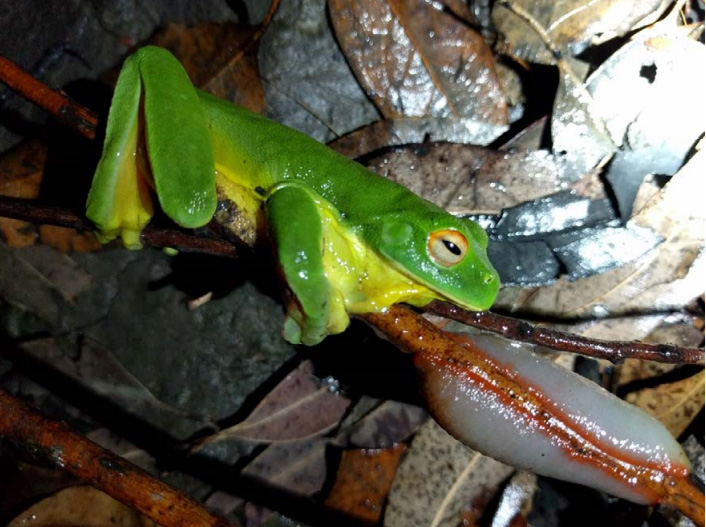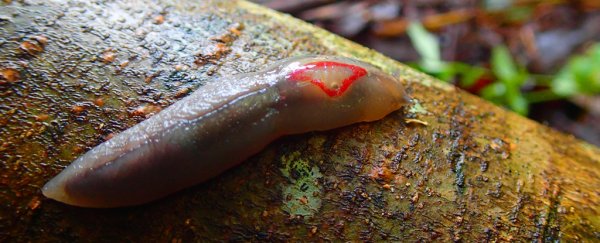Deep in the Watagans Mountain Range in Australia, a red-eyed green tree frog (Litoria chloris) had bitten off much more than it could chew.
Its dinner was to be an unassuming red triangle slug (Triboniophorus graeffei); instead, the frog ended up covered in a sticky mucus and completely stuck to a tree branch.
Researchers from the University of Newcastle stumbled across this weird situation and were immediately interested.
What had happened here? Did the slug really release enough mucus to stick a whole frog to a branch? The team sprung into action to find out.
 The frog in its sticky predicament (Gould et al., bioarXiv, 2019)
The frog in its sticky predicament (Gould et al., bioarXiv, 2019)
We already know that red triangle slugs are Australia's largest native land slug. Like its name suggests, it has a red triangle on its back, which features a breathing pore. Until now, however, nobody expected the species to have the assets to superglue whole frogs.
After the team observed the pair for 10 minutes, "no changes occurred so the frog and the nearby slug were then taken back to the Conservation Biology laboratory at the University of Newcastle for further investigation," they explained in their paper. They took the whole branch, by the way.
The poor frog was still stuck 24 hours later, so the researchers had to unstick it from the branch manually. As a slug defence mechanism, it's brilliant - it would make the incapacitated frog easy pickings for a bigger predator, and give the slug plenty of time to get away.
But the team still wasn't sure how this occurred. The normal mucus these slugs produce is thin, and not sticky at all. So, they gave their specimen a good poke to provoke it.
"Often a single touch of the dorsum resulted in contractions in the area and the immediate secretion of mucus, which was expelled onto the surface in the form of tiny droplets that quickly spread over the surrounding surface," the team explained.
"This mucus became adhesive within a matter of seconds and often resulted in the fingers of gloved hands becoming stuck together or to surrounding paper and plastic when handled."
The team confirmed these results by collecting three more slugs and investigating their mucus, too. They concluded that the frog was indeed glued to the branch by the sticky defence mucus.
"This appears to not only be the first description of defensive mucus production in this slug species but one of the first natural observations of the use of adhesive defence secretions to incapacitate a predator," says the team.
What's more, while the slug's defensive mucus loses its stickiness when it dries, it will regain it when wet. As frogs excrete their own mucus to keep their skin moist, this defence seems designed to work exceedingly well against these amphibians.
This fascinating study hasn't been peer reviewed yet, since we found it on the pre- peer review website bioRxiv - so there might be a few changes before the final version of the paper.
But it's still a super exciting find for the researchers – especially for an accidental discovery - now they just need to figure out how the slugs don't get stuck themselves.
"That is the big question," one of the team, Jose Valdez of Aarhus University in Denmark, told Michael Le Page at New Scientist.
"The answer is that no one knows, not only for this species, but all other species which produce adhesives for defence or predation."
The research has available on pre-print server bioRxiv.
